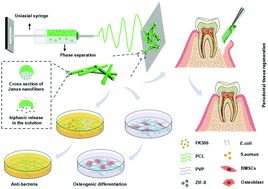A periodontal tissue regeneration strategy via biphasic release of zeolitic imidazolate framework-8 and FK506 using a uniaxial electrospun Janus nanofiber†
Abstract
Guided tissue regeneration (GTR) strategies are an effective approach to repair periodontal defects by using GTR membranes. However, commercial GTR membranes still have limitations in periodontal tissue regeneration owing to lack of antibacterial and osteogenic properties. The development of novel Janus nanofibers with biphasic release characteristics based on the therapeutic needs of GTR is essential to tackle this issue. Here, we developed a multifunctional Janus nanofiber via uniaxial electrospinning, with zeolitic imidazolate framework-8 nanoparticle (ZIF-8 NP) loading in the hydrophilic polyvinylpyrrolidone (PVP) part and FK506 embedding in the hydrophobic polycaprolactone (PCL) part. The release of Zn2+ conformed to the Ritger–Peppas kinetics which could effectively prevent bacterial infection, and the release profile of FK506 was fitted to a first-order equation which could provide persistent osteogenic stimulation for osteogenesis. The periodontal tissue regeneration data from a rat periodontitis model revealed that the multifunctional electrospun Janus nanofibers could be used as an effective bioplatform to restore alveolar bone impairment, compared with the control group. In summary, the Janus nanofibers with biphasic release characteristics quickly exert antibacterial function as well as continuously provide a microenvironment beneficial to the osteogenesis process, demonstrating its great potential for GTR treatment in dental clinic applications.



 Please wait while we load your content...
Please wait while we load your content...